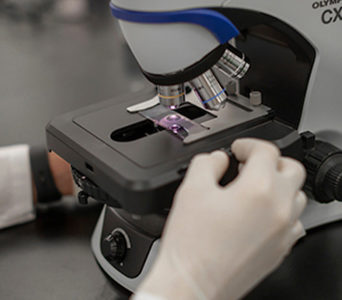Path to Treatment
One of the major goals of the Chromosome 18 Clinical Research Center is to develop a path to treatment for conditions involving chromosome 18. This is a multi-step process that takes years.
The path to treatment for genetic conditions is not necessarily a linear one. Progress towards treatments goes in starts and stops. Treatments for one aspect of a genetic condition may be developed long before we have hint of how to start treating another aspect.
The overall path to treatment is outlined on this page. We hope that this explanation will help you to understand the process as well as the progress we have already made in the treatment of chromosome 18 conditions.
The process
- Review of the medical literature
The first step along the path to treatment is to perform a thorough review of the medical literature. It is important to know what work has already been done! The literature review creates a collection of all the individual case reports and research studies that provide any information on the condition. This is typically diagnostic and general observational information. The literature helps us to identify gaps in our knowledge about a condition and guides our next steps. - Clinical assessment
Using the information gathered from the literature review as a guide, a comprehensive clinical assessment can be performed. The literature review helps ensure that all the different aspects of the conditions that have been previously described are assessed. This assessment is ideally done by a single team of investigators using a consistent protocol. This ensures that the information gathered is consistent between the different participants and can be collected into a single syndrome description. In addition, the clinical assessment can be focused on looking for causes. For example the literature review may show that short stature is a common feature in people with the condition. Since short stature can have many causes, the clinical assessment can be focused on determining the underlying cause of short stature. A clinical assessment that is looking for the root causes may also be able to identify existing treatments for some of the features of the condition. - Syndrome description
A syndrome description is a comprehensive collection of all the different findings from a large group of people with the condition. This means that it will include the common features of the condition but some uncommon findings as well. The uncommon finding may or may not be a consequence of the condition. For example in a large group of people there is likely to be someone with asthma independent of the condition. So while a syndrome description is important it is insufficient for helping someone know how they are most likely to be affected. - Gene identification
The next step in the path to treatments is to identify the underlying biological mechanisms. Some hints about this will come from the clinical assessment. However, the analysis for the genetic material (DNA) from many individuals can be used to help identify key genes. We expect that only about 5-10% of the genes on chromosome 18 will be responsible for the medical and behavioral problems experienced by people with deletions or duplications of parts of the chromosome. There are just over 300 genes on chromosome 18. So we need to determine which 15 – 30 genes are the key genes. - Syndrome management plan
Once the key genes are identified, then a general management plan can be created. For example, after someone has been diagnosed with 18p-, then the molecular analysis can be performed so they know exactly which genes are present in one copy instead of two. Then from that list of genes, the key genes related to specific features can be identified and a set of expectations can be created for that individual. This also means that one would know which features sometimes associated with the condition do not apply to them. - Gene function studies
Once the key genes are identified, then intensive work can be focused on the functions of those particular genes. This is where the work of many labs around the world can be drawn upon for help. Some genes already have an extensive literature about their function and some have absolutely nothing. There are currently an large variety of technologies developed for investigating gene function including mice with one copy instead of two of many different genes. - Treatment development
Integral to the gene functions studies are experiments to discover and learn about the molecules that control the expression of individual genes. The goal would be to identify specific drugs that can up-regulate one copy of a gene do the work of two or down-regulate three copies of a gene to do the work of two. - Animal models
Any potential treatments would first be tested using mice with the same copy number change as the potential patients. So a drug to up-regulate gene A would be tested in a mouse with one copy of gene A to see if the drug helped normalize the effect of the missing gene. Since we are expecting to identify 15-30 key genes this process would have to be applied 15- 30 different times, once for every key gene. Also, there may already be approved therapies for some of the features of the condition, so some treatments may not require starting at this basic science level. - Clinical trials
Once potential treatments are successfully tested in animal models, the next step is to see if people gain the same positive benefits from the treatment. This will require clinical drug trials. These trials are highly regulated by the government to ensure maximal patient safety. - Individualized treatment plans
When we reach the end of our path to treatments, the experience for future families will be very different from those who came before them. They will not only be able to learn what to expect, but they will learn about treatments as well. This treatment plan will be designed for their child”s specific deletion or duplication.


